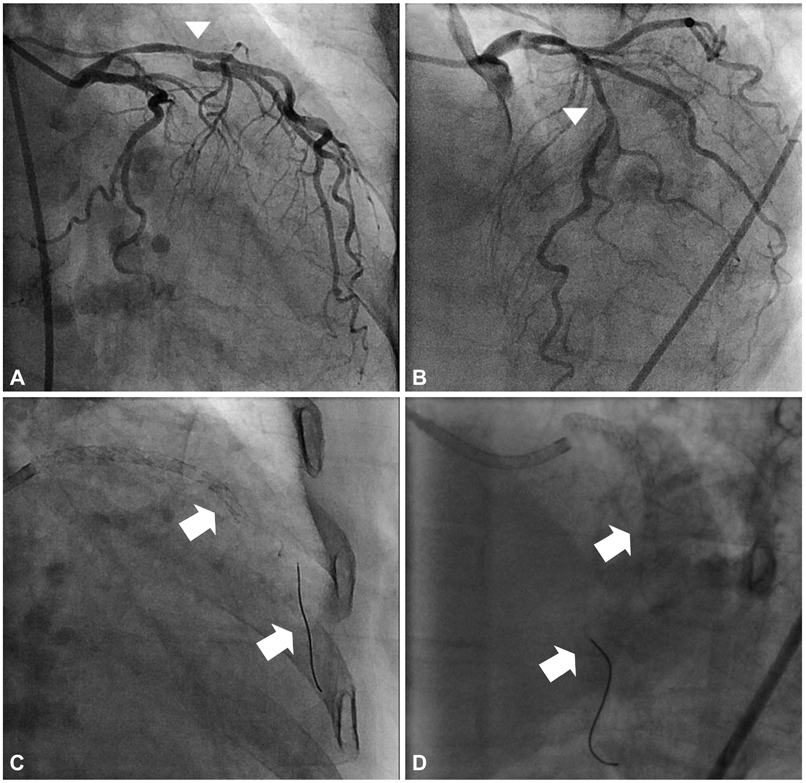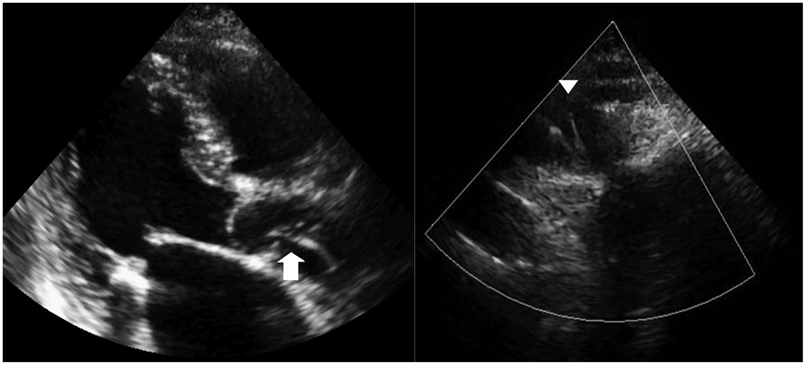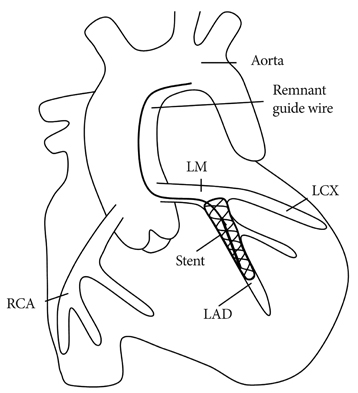Korean Circ J.
2010 Sep;40(9):475-477. 10.4070/kcj.2010.40.9.475.
A Case of Guide Wire Fracture With Remnant Filaments in the Left Anterior Descending Coronary Artery and Aorta
- Affiliations
-
- 1Department of Internal Medicine, Chonbuk National University Medical School, Jeonju, Korea. medorche@jbnu.ac.kr
- KMID: 1456143
- DOI: http://doi.org/10.4070/kcj.2010.40.9.475
Abstract
- Guide wire fractures during percutaneous coronary intervention (PCI) are very rare, but when they do occur they may lead to life-threatening complications, such as embolization, thrombus formation and perforation. In cases when percutaneous retrieval has failed, surgical extraction of the remnant fragments is recommended. We present a case of remnant guide wire filaments that remained in place without complications, over a one-year clinical follow up period.
MeSH Terms
Figure
Cited by 1 articles
-
Percutaneous Treatment of an Injured Coronary Stent Using the Looping Wire Technique
Lae-Young Jung, Sang-Rok Lee
Chonnam Med J. 2013;49(3):129-132. doi: 10.4068/cmj.2013.49.3.129.
Reference
-
1. Cafri C, Rosenstein G, Ilia R. Fracture of a coronary guidewire during graft thrombectomy with the X-sizer device. J Invasive Cardiol. 2004. 16:263–265.2. Doorey AJ, Stillabower M. Fractured and retained guide-wire fragment during coronary angioplasty: unforeseen late sequelae. Cathet Cardiovasc Diagn. 1990. 20:238–240.3. van Gaal WJ, Porto I, Banning AP. Guide wire fracture with retained filament in the LAD and aorta. Int J Cardiol. 2006. 112:e9–e11.4. Lee HJ, Son MS, Ju KT, et al. An unusual case of guide wire fracture during coronary artery stenting for bifurcation lesion. Korean Circ J. 2001. 31:1200–1202.5. Khonsari S, Livermore J, Mahrer P, Magnusson P. Fracture and dislodgment of floppy guidewire during percutaneous transluminal coronary angioplasty. Am J Cardiol. 1986. 58:855–856.6. Woodfield SL, Lopez A, Heuser RR. Fracture of coronary guidewire during rotational atherectomy with coronary perforation and tamponade. Cathet Cardiovasc Diagn. 1998. 44:220–223.7. Collins N, Horlick E, Dzavik V. Triple wire technique for removal of fractured angioplasty guidewire. J Invasive Cardiol. 2007. 19:E230–E234.8. Chang CP, Lin JJ, Hung JS, Pai PY, Hsu CH. Retrieval of dislodged coronary intravascular ultrasound catheter with embolic protection de-vice. Int Heart J. 2009. 50:121–125.9. Alexiou K, Kappert U, Knaut M, Matschke K, Tugtekin SM. Entrapped coronary catheter remnants and stents: must they be surgically removed? Tex Heart Inst J. 2006. 33:139–142.10. Hartzler GO, Rutherford BD, McConahay DR. Retained percutaneous transluminal coronary angioplasty equipment components and th-eir management. Am J Cardiol. 1987. 60:1260–1264.11. Kilic H, Akdemir R, Bicer A. Rupture of guide wire during percutaneous transluminal coronary angioplasty, a case report. Int J Cardiol. 2008. 128:e113–e114.
- Full Text Links
- Actions
-
Cited
- CITED
-
- Close
- Share
- Similar articles
-
- An Unusual Case of Guide Wire Fracture during Coronary Artery Stenting for Bifurcation Lesion
- Guide wire fracture during percutaneous coronary intervention
- Angioplasty at Coronary Bifurcation
- Easy Exposure of Invisible Left Anterior Descending Artery
- A Single Coronary Artery with the Right Coronary Artery Originating from the Left Anterior Descending Artery Detected by Cardiac CT: A Case Report





